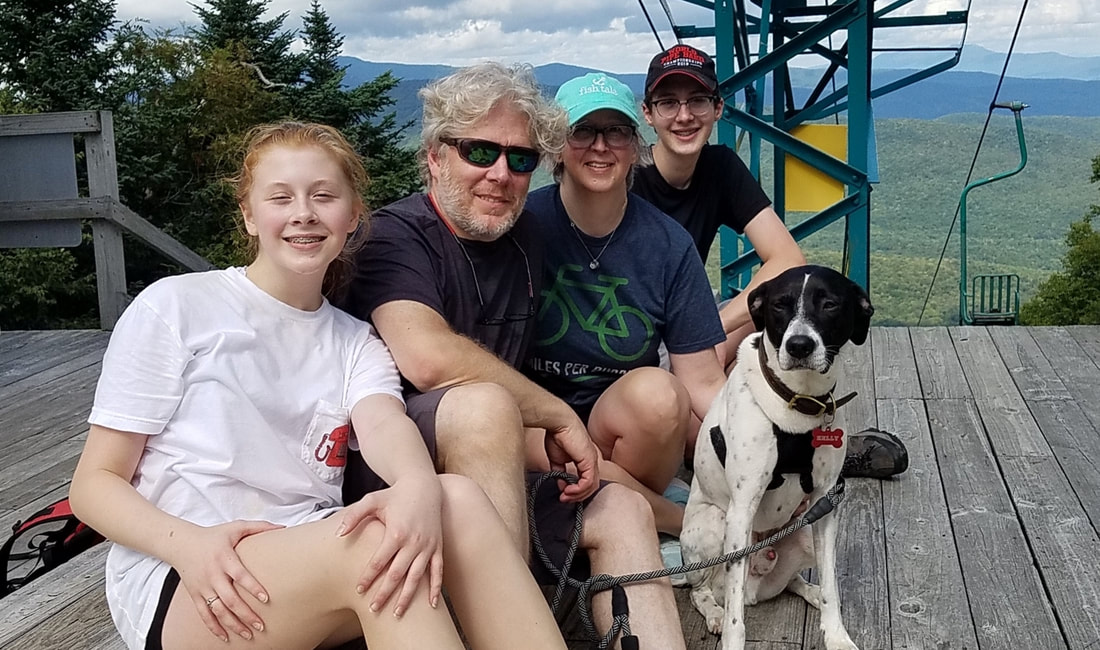 Name: Ken and Dana J. Dancers at SRL: Magnus “the Tall” and Greta “the Red-Haired” How long has your family been with SRL? Greta is in her 6th year and Magnus is in his 4th. Why Irish dance? Greta quit soccer, basketball, ballet, tap, AND jazz! We were just hoping something would stick. Courtney offered a week long mini camp that gave Greta a chance to try it out before committing to anything long-term. Magnus saw how much fun Greta was having! Favorite winter family activity? Skiing and board games. What’s your favorite dance-related memory? Dana: The hours in the car driving to class and to feiseanna, there is a lot of time to chat. Ken: Watching both kids dance a 4 hand with another sibling duo at the Yardgoats game. How do you think dance has positively affected your dancers? So many things! They have learned how to set long term goals and create plans to achieve them, time management and how to take corrections, the importance community and volunteerism, these are just a few. If you could meet any famous person, living or dead, who would it be and why? Dana: The person that invented the dishwasher. I owe them so much. Ken: Donald MacPherson, Scottish legendary piper, teacher and one of the most successfully competitive solo pipers of all time. What’s your secret talent? Ken: Sarcasm. Dana: Gifted in the campfire starting arts. How did you choose your dancers’ names? Why? We wanted uncommon, but easy to pronounce names. There was a pro cyclist, Magnus Backstedt that gave us the inspiration for the boy's name. The name Greta goes well with Magnus…especially when shouting. What’s the most important quality to have in life? Integrity. What advice would you give parents who are looking to try out Irish dance? Do it! At least try it out. They will learn so much and it is a great opportunity to make friends outside of school. And always bring snacks. This post is part of a series. Meet our last spotlighted parent, Andrea K., here. Check out the blog every Monday and Thursday for more posts about Irish history, dance culture, community news, and spotlights on our dancers, staff, and families—among other fun projects! And don’t forget to dance along with us on both Facebook and Instagram.
0 Comments
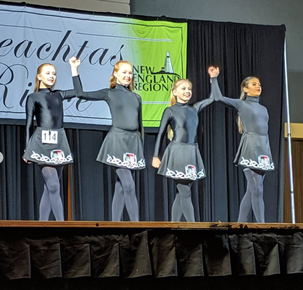 SRL dancers on stage at the New England Regionals in January 2020 SRL dancers on stage at the New England Regionals in January 2020 Levels and Competitions, Part 2 Many of our parents and dancers here at SRL are fully aware of all the ins and outs of Irish dance, and this post isn’t really for them (unless they’ve always been a little fuzzy on some of it—we won’t tell! It’s complicated!) This post is for our Beginner parents, our dancers just getting excited about maybe competing, or even the parent just checking out our website for the first time. (If that’s you, maybe check out our five previous posts in the series to catch you up to the present in Irish dance’s history!) Leveling Up Note: the following is a general overview and varies by region—this guide is for our region, New England, USA. Your dancer’s instructor is always the best authority on any and all information pertaining to the competitive track in your area and your dancer’s level, specifically. Competition level names and our class level names may share similar terms, but are not directly related. There’s a quote written on the mirror in the larger studio here at SRL: “You earn your medals in class, you pick them up at competition.” Today, we’re going to lay out how the levels work on the Irish dance competitive circuit, but these levels aren’t about the shiny dresses and big hair—they’re about the discipline, hard work, and practice, practice, practice. The CLRG says it best: The purpose…is to provide a structured framework within which dancers can progress towards an achievable goal. [It] provide[s] a strong foundation in Irish Dance by developing a candidate’s physical skills, stamina, expression, musicality and an appreciation and knowledge of the traditional dances and culture. But, the competition must go on! To explain this all in the most basic way: competing and placing in a feis (check out Part 1 if this term is new to you!) is how dancers move up from one level to another. But the rules and regulations involving that movement are anything but simple. 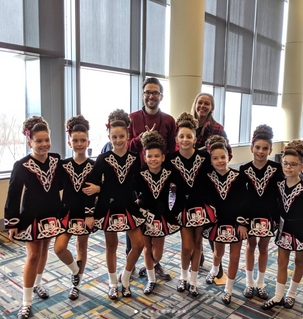 SRL dancers with Director, Courtney, and Instructor, Christian, at a regional competition in January 2020 SRL dancers with Director, Courtney, and Instructor, Christian, at a regional competition in January 2020 Let’s take a closer look at the lower and intermediate levels, usually called “grades”: Beginner Grade: This level is for dancers ages 6+ that are brand new to competing for their first calendar year in the competitive circuit. Once a dancer has learned the necessary skills and steps at class—two steps of reel and light jig—they are eligible to take part in their first feis at the Beginner level. It’s always exciting to get on stage with the possibility of earning a medal for their hard work in class! Advanced Beginner Grade: Students remain at this level until they place 1st, 2nd, or 3rd in a competition of at least 5 competitors. They move up when competing in the next calendar year and only within the type of dance they placed in—i.e. a dancer can be a Novice in the Slip Jig, but still an Advanced Beginner in the Reel. You are not considered in the next level fully until you move up in all your dances. Novice Grade: This is the level where things begin to get more complicated—the steps get more difficult, and the tempo of the music may be slowed in order to fit more and more advanced steps into the dancer’s performance. Novice dancers move up only if they place 1st in a competition of 5 or more dancers, though groupings of 20 or more dancers will move 1st and 2nd place up to the next level in that specific dance. This is the level where solo costumes (as opposed to your school’s costume) are allowed. 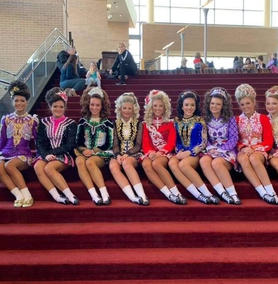 SRL dancers of Novice Grade and above in their solo dresses in 2019 SRL dancers of Novice Grade and above in their solo dresses in 2019 Prizewinner Grade: An advanced level competitor that has placed fully out of Novice Grade, but is working on rising to the level of Preliminary Championship Grade. The regional minimum to advance requires a dancer to place 1st in both a hard shoe and soft shoe dance in order to move up, but, as the final grade before Championships, SRL dancers are required to win all their Prizewinner dances in order to advance. Now, let’s explore the championship levels, where the dancing is extremely advanced and dancers begin to compete at the regional, national, and international levels: Preliminary Championship: Competitors at this level generally perform three dances: soft shoe, hard shoe, and a set dance. At the championship levels, the soft and hard shoe dances get longer than they were in the grade level—this requires more stamina and strength. At Preliminary Championship level dancers are invited to represent SRL at the regional championships held each November. A dancer must win 1st place twice in order to advance to the top level of Irish dancing—Open Championship—and qualify for Nationals. Open Championship: The highest competitive level. Similar to the prelim level, dancers perform a longer soft shoe dance and a longer hard shoe dance, along with a set dance. Set dances are a dancer’s solo piece that showcases their best strengths, impeccable rhythm, and musicality. If a dancer wins a 1st at this level, they may never return to competing in Prelim. Open Championship dancers are pursuing high placements at regional and national championships and working to qualify for the world championships (often competing at major championships--The All-Irelands, The All-Scotlands, The Great Britains, etc.—though this past year saw the cancellation of many.) 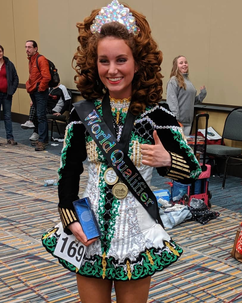 An SRL dancer qualifying for Worlds in 2019! An SRL dancer qualifying for Worlds in 2019! While most Irish dancers start young and finish their competitive careers by their early twenties, many feiseanna offer competitions for older age ranges, as well! SRL offers recreational adult classes in six-week night sessions—perfect for dipping your toe in the Irish dance world! Feiseanna are competitive, but they’re also a cultural touchstone—bringing together people of every walk of life to celebrate painstakingly developed skills that bring alive Ireland’s vibrant history and culture. This post is part of a series. Read Part 1 of Levels and Competitions here. Check out the blog every Monday and Thursday for more posts about Irish history, dance culture, community news, and spotlights on our dancers, staff, and families—among other fun projects! And don’t forget to dance along with us on both Facebook and Instagram. 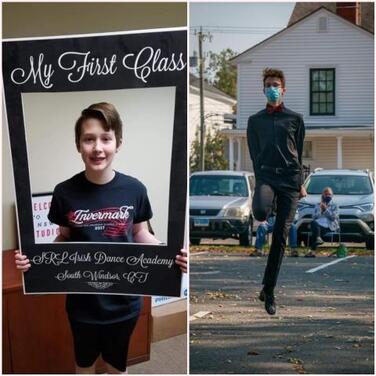 Name: Magnus Age: 15 How long have you been dancing with SRL? Why SRL? I have been with SRL for 4 years. I really enjoy the environment Courtney’s created. How did you get started with Irish dance? At first, I watched my sister do the performances and feiseanna. I thought it was really cool so I decided to try it. Who do you look up to? I would have to say mainly my parents and teachers. What’s your favorite dance-related memory? My favorite dance related memory was my first feis. I remember it being a lot of fun and having a great day with my family. What three items would you bring to desert island with you? (Assuming you already have food, fresh water, and shelter.) I would bring a soccer ball, a fishing pole and books. If you could live anywhere in the world, where would you live and why? I would live in Bar Harbor Maine. I want to live here because of the gorgeous scenery and hiking trails. I also love to fish and there are many spots where you can. I also have great memories of when I was younger and we would go hiking and camping there. What’s your favorite thing about dancing? My favorite thing about dance is the competition. I like that in Irish dance you can show off how much you've learned and progressed through competitions. If you were a fictional character, who would you be and why? I would definitely be Obi-Wan Kenobi because I think the fact that he can control things with the force is pretty cool. If you could snap your fingers and instantly make the world better, what would you do first? I would get rid of Coronavirus. What’s the best advice you can give a new or younger dancer? The best advice I can give a newer dancer is to stick with it and have fun. This post is part of a series. See our Q&A with another SRL dancer, Ellie H., here. Check out the blog every Monday and Thursday for more posts about Irish history, dance culture, community news, and spotlights on our dancers, staff, and families—among other fun projects! And don’t forget to dance along with us on both Facebook and Instagram. 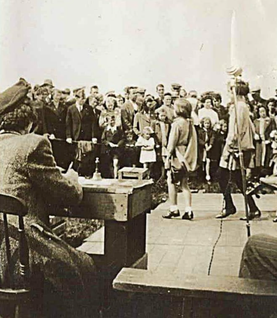 Vintage feis photos courtesy of @once_upon_a_feis on Instagram Vintage feis photos courtesy of @once_upon_a_feis on Instagram Levels and Competitions, Part 1 Many of our parents and dancers here at SRL are fully aware of all the ins and outs of Irish dance, and this post isn’t really for them (unless they’ve always been a little fuzzy on some of it—we won’t tell! It’s complicated!) This post is for our Beginner parents, our dancers just getting excited about maybe competing one day, or even the parent just browsing out our website for the first time. (If that’s you, check out our four previous posts here to catch you up to the present in Irish dance’s history!) A little recap: It was the Gaelic revival in the late 19th century, and the forming of the Conradh na Gaeilge (Gaelic League) in 1893, that helped Irish dance truly begin its journey from unrecorded folk tradition to the international, competitive art form it is today. With the League’s creation of a governing body specific to dance in the 1930s (Coimisiún Le Rincí Gaelacha—aka The Irish Dancing Commission or CLRG—still the primary governing body of Irish dance today,) Irish Dance Masters became a legitimate authority on a world stage (no pun intended.) The world of Irish dance as we know it today was built on this bedrock: the CLRG set down a series of rules and regulations to govern and standardize Irish dance (everything from steps and form to certifications for teachers.) This led to the creation of competitive opportunities to elevate its reputation, preserve and promote Irish culture, and nurture the art. And those competitions, rules, and regulations are what we’re here to discuss with you today! Feis Out the Best We’ve discussed feis and feiseanna (pronounced fesh and fesh-anna) before in this series—meaning simply “festival(s)”—they’re a long-standing tradition meant to celebrate and preserve Irish culture. Feiseanna today are still much the same (though in the dance world, they may only be a dance competition and not have as many outside vendors,) and vary in size: dance academies often hold inter-school class feiseanna, but there are also larger, regional feiseanna all over the world. These competitions are divided by both age and skill level (discussed next week!) and competitors are judged on a variety of technical and stylistic concerns such as timing, turn out, foot placement, deportment, choreography, rhythm…the list could fill this entire post. 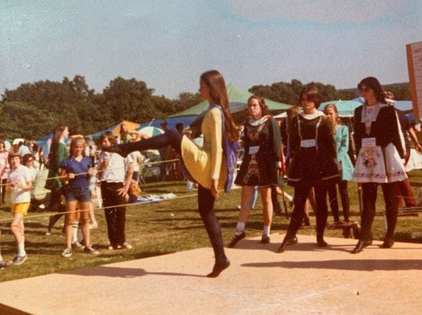 @once_upon_a_feis @once_upon_a_feis To put this all as simply as possible: dancers compete in multiple different dances divided into two major categories: hard shoe and soft shoe. From those larger categories, more specific ones emerge based on the music and its timing, in three broad categories: jig, reel, and hornpipe (though the slip jig is completely unique in Irish music and dance with a 9/8 time signature—we’ll explain further below!) Soft shoe dances include the reel, the light jig, the slip jig, and the single or hop jig, while hard shoe dances include the treble or double jig, hornpipe, and treble reel. Most feiseanna will have dancers beyond the earliest levels compete in soft shoe rounds, hard shoe rounds, and then a final round that’s often hard shoe, and often a set dance (more about that below.) Some feiseanna will include team or cèili (pronounced kay-lee) dances, as well. But how does a dancer get to be a competitor? Dancers begin preparing for competition at the earliest levels: every move they learn in their Beginner later becomes part of a dance. Beginners start with the basic reel and jig. Once a dancer has mastered these basic steps and has good control of their technique, they begin learning hard shoe with the treble jig (essentially a hard shoe version of the jig they’ve already mastered and know the music for—but with hard shoe skills and movements instead!) Hornpipe and traditional set dances are added as a dancer progresses in their hard shoe technique. Each dancer will gradually add more complexity to these basic dances, differing in rhythm and timing, as they develop as dancers—for example: over time, the basic steps of the reel, light jig, and slip jig are upgraded with more difficult choreography. Traditional set dances are unique, tune-specific dances that were choreographed long ago by Dance Masters in Ireland to exactly match the music. They have titles such as “St. Patrick’s Day,” or “Garden of Daisies,” and are largely universal around the world (though there are slight regional and studio variations.) This is different to other types of dances (reel, jig, slip jig, treble jig, and hornpipe) that are unique to each school. This is why (well, at least until 2020 forced many competitions online) videotaping Irish dance competitions has always been forbidden—you have to protect that choreography!  What the layperson needs to understand in order to hear the differences in dances/music really comes down to is the timing: different dances have differences in their beats per bar of music, as well as different emphasized beats. Here’s a little breakdown of the major groupings, though further designations into dances have even further and more complicated variations (check out a musical theory breakdown of each one here and click on each type of music to hear an example!): Reels: 4/4 time signature and will probably sound the most “normal” to a non-dancer as the beats are evenly emphasized. Can be detected if you can say “double decker, double decker” in time with the music. Jigs: 6/8 time signature, i.e. three beats per bar with the 1 and 3 emphasized (non-Irish dancers will recognized this as a waltz.) Detected by non-dancers by saying “carrots and cabbages, carrots and cabbages” in time to the music. Includes light jigs and treble jigs, but not slip jigs! Slip Jigs: 9/8 time signature, i.e. similar to the above jig but with three beats per bar and three eight notes in one beat (with the emphasis on the 5 and 9 beats.) This one can give a lot of dancers some difficulties at first—it has an almost rolling sound to it! Hornpipes: 4/4 time signature, like the reel, but with the 1 and 3 beats emphasized. There’s more variation here, but many hornpipes can be detected with “humpty-dumpty, humpty-dumpty.” Next week, tune in to the blog for the purpose of feiseanna competitions (besides fun!): rising through the levels or “grades.” This post is part of a series. Read more about how Irish dance's iconic form developed here. Check out the blog every Monday and Thursday for more posts about Irish history, dance culture, community news, and spotlights on our dancers, staff, and families—among other fun projects! And don’t forget to dance along with us on both Facebook and Instagram. 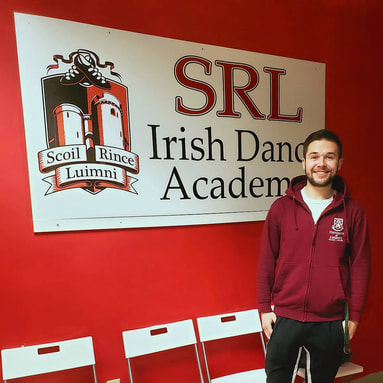 Name: Christian Cairone TCRG Position: Instructor How long have you been working at SRL? Almost 2 years. Why SRL? I loved the atmosphere that Courtney had created and wanted to be a part of the team. How long have you been dancing? I was a competitive dancer for 20 years, but I've been dancing since I was 3. Why Irish dance? My older brother saw Riverdance on TV and wanted to start doing it. I went to the first practice and was hooked. My teacher at the time didn't allow for children to dance at 2, so I would go to class and dance in the back of the room doing everything everyone was doing in class. My teacher let me start the following year and I haven't looked back! What did you want to be when you grew up when you were little? Why? I always wanted to be a veterinarian because I loved animals so much growing up. What are you interested in that most people aren’t? Star Wars and culinary arts. What weird food combination do you enjoy? As a chef I love many different flavor combos, but the strangest might just be: a piece of toast with peanut butter, topped with an over-easy egg. (Trust me, you need to try it!) How has dance affected your everyday life? Dance has given me the ability to have friends all around the world that share the same love and passion for Irish dance that I do. What’s the coolest place you’ve ever visited? (Remember travel?!) The Azores, which is a subsection of islands off the coast of Portugal. What movie can you watch over and over and never get tired of? Why? Dr. Seuss’s How the Grinch Stole Christmas. It was a story my grandfather would read to me all the time when I was a kid and whenever I watch it I always remember him and the different ways he would tell the story. If you could have a superpower, what would it be? I would love to time travel! Why do you think people dance? I believe there are many reasons behind why people dance, including because friends or family members did it in the past or currently do it now. But I think that some people dance for the same reason I did: for a way to escape reality from time to time. I remember going to the studio, totally forgetting about the outside world, and just living in the moment that was happening throughout dance class. What advice do you have for aspiring dancers? The best advice I have is this: "Believing in yourself is the first step to achieving greatness." This post is the last in the series (at least for now!) Meet our whole staff: Courtney, Bailey, Codi, Devon (and, of course, Christian, above,) through their Q&As. Check out the blog every Monday and Thursday for more posts about Irish history, dance culture, community news, and spotlights on our dancers and families—among other fun projects! And don’t forget to dance along with us on both Facebook and Instagram. Dr. James Barry In 1809, a short, slight man named James Barry boarded a boat in his hometown of Cork and set sail to Edinburgh where he planned on enrolling in medical college. Barry’s previously affluent family had fallen on hard times—his father had been let go from his position due to rampant anti-Catholic sentiments and eventually landed in a debtor’s prison. At nineteen, Barry had been well-educated by his tutors with the intention of becoming a tutor himself—but with no work experience and a disgraced family name, there was no work to be had. Barry’s height, soft voice, and delicate features (hard to see in the not particularly skilled portrait that’s our only image of Barry from the time period, featured here) led many to believe that Barry was lying about his age once he reached Edinburgh. While the faculty there had let Barry in to study, they were reluctant to let him take his final exams to become a doctor. Luckily, a friend of the family, the Earl of Buchan, vouched for the young man, and in 1913 Barry went to London (where his family now lived) to pass his exams and become Dr. James Barry at the age of 22. And it’s a good thing he did: Dr. James Barry’s fifty-plus year long career as a military doctor proved to be an illustrious one. He entered the service as an officer and quickly rose in the ranks to eventually become Inspector General in charge of all military hospitals—a role equivalent to Brigadier General. While his personality left much to be desired—there’s the complaints about him Florence Nightingale made in her diary (she thought him “a brute,”) as well as his court-martials and duels—Barry was a surgeon of unprecedented skill. Most notably, while stationed in Cape Town, South Africa in 1820s, he performed the first successful caesarian section where the mother and child both survived in modern history. His legacy also includes his tireless efforts in sanitation reform, as well as better medical practices and care for soldiers, military families, prisoners, lepers, and all other underserved communities before his death in 1859. Many are still benefitting because of his efforts till this day. And that would be the end of Dr. James Barry’s story, if it wasn’t for a charwoman who didn’t follow instructions. Barry left some specific last wishes: to be buried in the clothes he died in, with his body unwashed. But when the woman tasked with laying out the dead reached Barry, she stripped the body to prepare him for burial and found something shocking: Dr. James Barry not only had female anatomy, but stretch marks that implied she had once carried a child. While Barry’s colleagues and friends were perfectly happy to keep this fact to themselves, (Barry’s doctor, Major D.R. McKinnon, said in a letter that it was “none of [his] business” if Barry was actually female,) the revelation was leaked to the press and became a sensation. Many people claimed to have known the whole time, but it’s equally possible no one did: when Barry entered the military in his twenties, he entered as an officer, which requires no medical exam. Of course, we have accounts of Barry’s effeminate nature, but that brash personality seemed to have swayed a lot of people away from the truth.
However, the entire story above does stand as truth except for one thing: Barry’s name. Barry was actually born Margaret Ann Bulkley and only became James Barry when a number of liberal-minded family friends and mentors (including the Earl of Buchan, from earlier!) decided Margaret’s intelligence would be wasted as only a wife and hatched a plan that fooled the world for 56 years. Dr. James Barry remains one of the most accomplished humanitarians and surgeons of the 1800s, no matter their gender—we can just add the first female doctor in the UK and Ireland to their long list of accolades! This post is part of a series. Read more about Ireland's history by reading about ancient Irish Yule traditions here, here, and here. Check out the blog every Monday and Thursday for more posts about Irish history, dance culture, community news, and spotlights on our dancers, staff, and families—among other fun projects! And don’t forget to dance along with us on both Facebook and Instagram.  Name: Tara L. Age: 20 How long have you been dancing? Why Irish dance? Do you still dance? I was a competitive Irish Dancer for 15 years, regionally ranked numerous times at the New England Regional Oireachtas and nationally ranked at the North American Irish Dance Championships. I retired in 2019 after my freshman year of college. Irish dance was a life changing experience that provided me with so many opportunities to learn and grow. It was a daily challenge, which inspires my work ethic today. I always aim high and dream big. Through Irish Dance, I learned by working hard and practicing my craft, I could achieve anything. If you had to work, but didn’t need the money, what would you do? I think I would be a teacher, whether that would be for school or dance. I always loved my time as an assistant teacher for Courtney and still keep in contact with some of my students today. When they finally got their jumps or skips, it was such a proud moment for me. I miss working with them! If you could meet any historical or famous person, living or dead, who would it be and why? As everyone knows, I am a huge Taylor Swift fan. I would love to meet and interview her, asking how she got to where she is today, what does she hope fans take from her music, and why she decided to pursue a music career. I think she is such a great role model for young people and has such an interesting story that I would love to hear more about! What’s your favorite outdoor winter activity and why? I love ice skating with friends! It is so fun to skate with music and just have a good laugh. What advice do you have for aspiring dancers? There were many times during my career where I felt stuck and thought I would be better off quitting, but I did not. There were many times the chips did not fall my way, whether that be in class or at a competition, but I told myself that I had to keep trying because deep down I knew I could make my goals. My advice is no matter how the chips fall dance because you love it and because you can see yourself achieving your personal goals. Why do you think people dance? I think people dance because it is freeing. In Irish Dance, it is you and the floor working in harmony to produce something beautiful and culturally significant. It is a personal challenge, similar to golf, where the only opponent is yourself. It is also an opportunity to celebrate a culture very few understand. To represent and celebrate my Irish heritage through dance has connected me more with my family’s ancestry.  If you could have a superpower, what would it be? Why? I would love to mind read... it would have been super helpful to know what the judges were thinking while I was dancing! Now as a journalism major, I would love to know what my sources are really thinking when I ask them a question. What was your favorite SRL memory? My favorite memory was competing at my final North American Championships in 2018. It was probably the most fun I have ever had at a competition and I danced my personal best. While I fell just short of my goal, I admire the work I put in from January to competition day to put my best foot forward and succeed. However, I miss the daily classes the most. Seeing my friends and classmates always brightened my day and you never really knew what was going to happen that day! There were always plenty of jokes to go around! How do you think your time at SRL positively affects your everyday life as an adult? As an adult, my time at SRL taught me the value of time management, passion and persistence. Until college, I was a multi-sport athlete, competitive dancer and a participant in various other extracurricular activities. I learned quickly how to manage my school load with these other commitments to keep everything in balance. I hold myself to a high standard to do everything the best I can, so being able to manage that while maintaining a passion for the sport taught me so much. Today, I approach everything I do with passion and persistence while remembering I have to manage my time well to accomplish all of my goals. What’s the most important quality to have in life? The most important quality to have in life is to be hardworking. Without some level of hard work or effort, you will never reach your full potential. Talent can only get you so far. Hard work gets you to the finish line. This post is part of a series. See our Q&A with another former dancer, Lindsey H., here. Check out the blog every Monday and Thursday for more posts about Irish history, dance culture, community news, and spotlights on our dancers, staff, and families—among other fun projects! And don’t forget to dance along with us on both Facebook and Instagram. Check out our first ten fun facts here! 1. The Wild Atlantic Way is the longest, uninterrupted coastal driving route in the world. Officially opened in 2014 by the Irish tourism board, the route covers the entire west coast of the country, from the border of Northern Ireland all the way to (almost!) Cork. Passing through three provinces and nine counties, the route displays some of Ireland’s most beautiful scenery. 2. As Dracula is set largely in England, most people don’t realize its author, Bram Stoker, is an Irishman. In fact, the character of Dracula and this concept of vampires that became our standard was based on the Irish legend of the Abhartach. 3. The Titanic was built in Ireland—in Belfast at the Harland and Wolff shipyard, specifically. Pre-COVID, there was even a large, interactive, narrative monument and museum dedicated to Belfast’s shipbuilding called “Titanic Belfast.” (Miss Courtney's been!) 4. While we tend to think of it as an “Irish accent,” there’s really hundreds of Irish accents, all specific to different areas, education levels, and classes, with a variety of complex, social histories behind them. (Though phonologists tend to divide all these varieties into 3-5 larger groupings.) 5. The Croaghaun Cliffs on Achill Island in County Mayo are the third highest sea cliffs in all of Europe at 752 meters (that’s about half a mile!) Only Hornelen in Norway (860 meters) and Cape Enniberg on the Faroe Islands (754 meters) has them beat! (Barely.) 6. There’s evidence that people have populated Ireland for over 10,000 years. It’s a little later than much of Europe due to the climate (and the fact it’s an island,) but impressive nonetheless! The oldest artefacts have been found in the North of the country. 7. Ireland once had its own version of the Olympics! They were called the Tailteann Games (or the Lughnasa games after the Irish hero of legend, Lugh.) They took place in 1924, 1928, and 1932 and were a celebration of traditional Irish sporting events. Unfortunately, the event didn’t take off worldwide, but smaller versions still exist to this day! 8. Speaking of sport (as they’d say in Ireland,) Ireland has one of the oldest consistent sporting traditions in the world (at least 3,000 years old!): hurling. It’s considered the fastest game played on grass and bears a vague resemblance in equipment to field hockey or even lacrosse (though definitely not in play.) P.S. The women’s version of hurling is almost identical, but called camogie.
9. The hollow, hypodermic needle was invented by an Irishman and surgeon named Dr. Francis Rynd in 1844. The world’s first subcutaneous injection was even performed at the Meath Hospital in Dublin! Even if you hate needles, this was a revolutionary advancement that has allowed to save and better billions of people’s lives. 10. In 1970s Ireland (and still today at English boarding schools and some places in India) there was a tradition known as “bumps.” Essentially, if it was your birthday, you’d be grabbed by your classmates and thrown repeatedly into the air to be “bumped” on the floor, often upside down—once for every year of your life. It would often end in a big finale throw where you might or might not be caught on the way down. (You can see why it’s not often practiced these days!) This post is part of a series, read Volume I here. Check out the blog every Monday and Thursday for more posts about Irish history, dance culture, community news, and spotlights on our dancers, staff, and families—among other fun projects! And don’t forget to dance along with us on both Facebook and Instagram |
SRL NewsFind all of our latest news on our Scoil Rince Luimni Facebook page! Categories
All
Archives
August 2022
|
 RSS Feed
RSS Feed